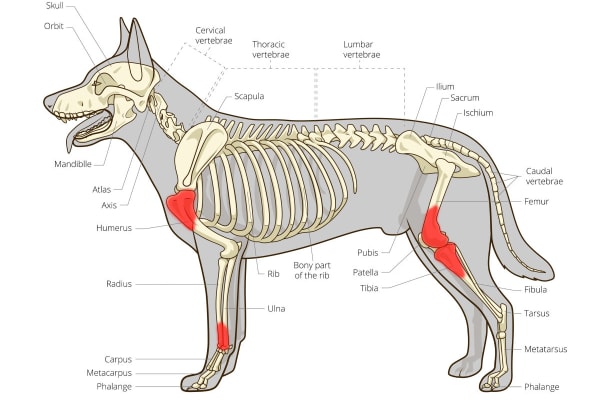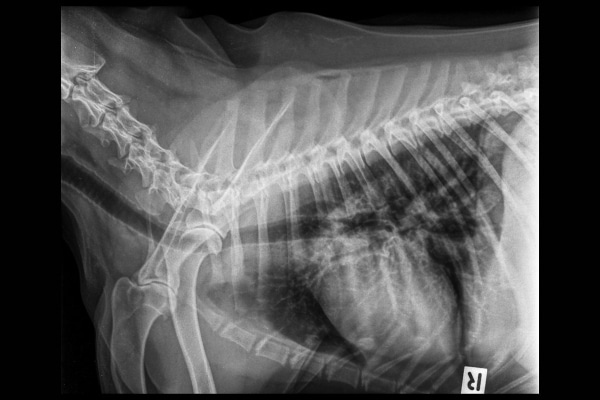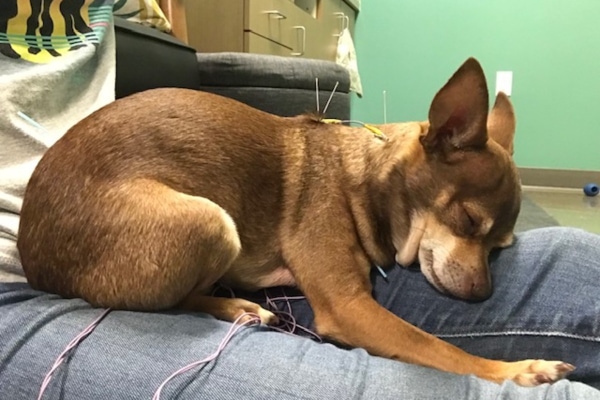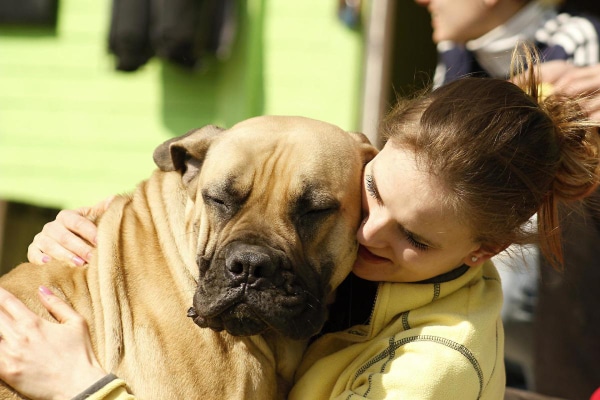Osteosarcoma in dogs can be a difficult diagnosis to face. No one wants to think about their beloved dog having cancer, especially painful bone cancer. Integrative veterinarian Dr. Julie Buzby explains the risk factors, signs, diagnosis, and treatment for osteosarcoma so you will know how to help and support your dog.

A dear friend and client brought her “heart dog,” Sadie, in to see me the other day. Sadie had been limping more frequently so her mom was worried that Sadie’s arthritis was progressing. Sadly, nothing could have prepared Sadie’s mom for what we would find that day.
When I examined Sadie, it was obvious she was favoring her right hind leg. Most of the pain was centered around her knee. To get a better idea of what was going on, I recommended taking some X-rays.
Instead of showing worsening arthritis like we suspected, Sadie’s X-rays revealed something far more sinister. The lower part of Sadie’s femur had a moth-eaten appearance that usually spells one thing in a senior dog—bone cancer.
Sadie’s mom was devastated. No one is every fully prepared to hear that dreaded “C” word. I hugged her and sat with her while she cried, and then we talked about what this meant for her sweet Sadie.
- What is osteosarcoma in dogs?
- What are the risk factors for osteosarcoma?
- Where does osteosarcoma typically occur?
- What are the symptoms of osteosarcoma in dogs?
- How is osteosarcoma in dogs diagnosed?
- What are the treatment options for osteosarcoma?
- What is the prognosis and survival rate for dogs with osteosarcoma?
- Saying goodbye to a dog with osteosarcoma
- Finding hope
- What advice do you have for others who are navigating osteosarcoma with their dogs?
What is osteosarcoma in dogs?
I explained to Sadie’s mom that Sadie most likely had osteosarcoma—the most common type of bone cancer seen in dogs. Unfortunately, osteosarcoma is an aggressive and malignant type of tumor which can easily spread to other places in the body.
Osteosarcoma occurs when the cells that are responsible for creating and breaking down bone begin to act abnormally and multiply out of control. Most commonly, this happens in the long bones of dogs, like their legs. However, osteosarcoma can be present in other bones and non-bony tissues as well.
What are the risk factors for osteosarcoma?
While any dog can develop osteosarcoma at any point in his or her life, there are some dogs who are higher risk.

While small dogs can get osteosarcoma, it tends to be more common in large and giant breed dogs. This seems to be due to height (i.e. taller dogs are at a higher risk due to rapid early bone growth) and/or genetic predisposition. Some of the predisposed breeds include:
- Boxers
- Golden Retrievers
- German Shepherds
- Great Danes
- Rottweilers
- Greyhounds
- Mastiffs
- Irish Wolfhounds
- Labrador Retrievers
- Scottish Deerhounds
Like many cancers, osteosarcoma is also more common in middle-aged and senior dogs. The median age of onset is seven years but it has been seen in dogs as young as six months old.
Where does osteosarcoma typically occur?
Not only are osteosarcomas more likely to be found in some breeds and ages of dogs, but they are also more common in certain bones—namely the long bones (i.e. the large bones of the limbs).
Vets use the saying—”Away from the elbow and towards the knee”—to help them remember exactly where in the long bones osteosarcoma likes to strike. As demonstrated by the picture below, osteosarcoma most often affects:
- The end of the radius near the wrist and the end of the humerus near the shoulder (i.e. the locations “away” from the elbow in the front leg).
- The portions of the tibia and femur that come together to form the knee joint (ie. the bones “towards the knee” in the rear leg).

However, osteosarcoma can technically attack any bone in the body, including the jaw, hips, toes, ribs, skull, spine, and nasal cavity. Plus, it can spread quickly to other bones or soft tissues. The most common site of metastasis is the lungs. While more rare, osteosarcoma can also metastasize to the mammary glands, muscles, and lymph nodes.
What are the symptoms of osteosarcoma in dogs?
As you can imagine based on the fact that osteosarcoma is a type of bone cancer, lameness tends to be one of the first symptoms.
Some of the other earlier symptoms include:
- Limping (to learn about other causes of limping, check out Why is My Dog Limping?)
- Abnormal gait
- Pain when the leg is touched
- Excessive licking of the leg or toes
- Decreased energy (i.e. a lethargic dog)
- Swelling of the leg or toes
- Loss of appetite
- Reluctance to walk or play
- Weight loss
If the cancer has spread to the lungs, there can be some respiratory signs as well. The most notable are:
- Heavy breathing
- Panting
- Coughing
- Collapse
- Dog who is breathing fast

If you notice some of the clinical signs on either of these lists, don’t delay in making an appointment with your veterinarian. As Sadie’s mom thought, osteoarthritis in dogs can cause many of the signs on the first list. So can osteomyelitis, which is swelling or inflammation in the bone due to bacterial or fungal infection. Plus, dogs can also develop other types of bone cancer—either cancer that starts in the bone or cancer that spreads to the bone from a different location.
The best way to determine if it is osteosarcoma versus osteomyelitis versus arthritis versus other bone tumor types is to make an appointment with your vet.
How is osteosarcoma in dogs diagnosed?
During the appointment, one of the first things your veterinarian will do is the physical exam. As part of the exam, the vet will also perform a detailed orthopedic exam. This will help your vet determine which part of your dog’s leg seems to be painful. Also, it will allow him or her to rule out other causes of limping including a dog ripping a nail off, thorns/stickers in the paw, wounds, luxating patella in dogs, etc.
X-rays
If your veterinarian suspects there is something going on with your dog’s bones, he or she will likely recommend X-rays. When osteosarcoma is present, the X-rays will show a “moth-eaten” appearance of the bones. This means that the bones will not look as solid as they should. This appearance is due to the cancer degrading the bone and/or laying down new bone in a disorganized fashion.
Sometimes the X-rays will also show a pathologic fracture. This is a fracture that occurs spontaneously due to the bone being so fragile from the cancer.
There are plenty of times when the vet can feel fairly confident about diagnosing an osteosarcoma on X-rays. However, sometimes bone tumors and other processes in the bone can look very similar. To try to get a more definitive answer, your veterinarian may send the images to a board-certified veterinary radiologist for a second opinion.

Fine needle aspirate
Your veterinarian might also recommend a fine needle aspiration (FNA) of the affected bone. This involves sticking a needle into the bone, removing some cells, and looking at them under the microscope and/or sending the slides to a board-certified pathologist for evaluation. Unlike a FNA of a lipoma in dogs or a dog lymph node which the vet can do awake, a FNA of bone requires anesthesia.
Based on the results of the FNA, the vet can usually distinguish between bone tumors and osteomyelitis (i.e. bacteria or fungus invading the bone). However, occasionally the FNA is non-diagnostic. In that case, the vet can advise you on the next diagnostic steps, such as a bone biopsy.
Tests to look for metastasis
Once your vet suspects or diagnoses osteosarcoma, he or she will likely recommend additional diagnostics to look for signs of metastasis. This is because in 80 to 90% of dogs, osteosarcoma has already spread to the lungs by the time of diagnosis.
The most common way to evaluate for metastasis involves taking three-view chest X-rays to look at the lungs. If the vet sees nodules in the lungs, this means the osteosarcoma has metastasized. However, just because the lungs look ok, this doesn’t rule out the possibility that the areas of spread are simply too small to show up on X-rays yet.
Your veterinarian also might recommend blood work and a urinalysis to get a better idea of your dog’s overall health status.
In some cases, your vet may suggest advanced imaging like a CT or MRI. This is more common when there is suspicion that lymph nodes are affected or if radiation therapy is being considered as a treatment option.
What are the treatment options for osteosarcoma?
Once your vet diagnoses your dog with osteosarcoma and completes the diagnostics needed to check for evidence of metastasis, he or she will help you formulate a treatment plan. Treatment options will depend heavily on the location of the tumor and if the tumor has spread.
Removal of tumor and prevention of spread
When there is minimal metastasis, there are two main goals of treatment. One is to prevent the cancer from spreading. And the other is to reduce or eliminate pain from the tumor.
The most common and most effective treatment option is a dog leg amputation. While this often seems like a scary and radical treatment plan to dog parents, dogs do very well on three legs. In fact, most dogs are actually more active after they recover from the surgery. This is because amputation of the affected limb removes the source of their pain.

In some cases where dog parents do not want to pursue amputation, limb sparing surgery may be an option. This is a less common cancer treatment because it is not as effective at limiting cancer growth. Plus, it requires a longer period of confinement during recovery than amputation does.
Limb spare surgery is generally only an option in cases where the cancer is very localized to one section of certain bones. In this procedure, the veterinary surgeon removes the diseased bone. Then he or she replaces it with a bone graft. Alternatively, the surgeon can perform a bone transport osteogenesis, which is a procedure that uses the dog’s own bone to bridge the gap in the bone.
Chemotherapy
Both amputation and limb spare surgery can be paired with chemotherapy to maximally prevent tumor spread or regrowth. Typically, this involves seeing a board-certified veterinary oncologist (i.e. a veterinary specialist who focuses on treating cancer). The oncologist can devise a treatment plan based on your dog’s specific situation.
There are a variety of different chemotherapy protocols that the oncologist may choose to use. Thankfully, dogs don’t tend to have nearly as many negative side effects from chemotherapy as people do. This means that electing to go with chemotherapy shouldn’t significantly decrease your dog’s quality of life during treatments. Plus, it has the potential to buy you and your dog more time together.
If you are weighing the options, I strongly encourage you to make an appointment to talk with a veterinary oncologist. The field of veterinary oncology is growing tremendously and new treatment options are becoming available all the time. The oncologist can lay out all your options and discuss the pros and cons so you can make the most informed decision possible.
Palliative care for dogs with osteosarcoma
The options we just finished discussing can be a great choice for some dogs and families. But for a variety of reasons, amputation or limb sparing surgery and chemotherapy aren’t the right choice for every situation. And that is ok. Some dogs wouldn’t handle walking on three legs very well because they have significant orthopedic issues. Other dogs are nearing the final stages of osteosarcoma by the time of diagnosis and already have metastasis to other bones or their lungs.
In these cases, owners and veterinarians may elect for palliative care (i.e. keeping a dog comfortable) rather than surgery or chemotherapy. I want you to know that this is a reasonable and loving option too. You aren’t giving up on your dog if you decide to go down this road.
I also want you to know that realistically, most dogs with osteosarcoma are going to end up needing palliative care at some point. Maybe initially their family will choose aggressive therapy. But the time may still come when, due to the progression of osteosarcoma, comfort care becomes the priority. So whatever you decide to do, this next section is still worth reading.
Pain management
Whether you choose dog hospice care from the beginning or eventually end up there after battling osteosarcoma with your dog for awhile, there are lots of ways to help your sweet pup have good days for as long as possible. The most important aspect is pain management. Often this will be multi-modal pain management, meaning the vet combines a variety of medications and therapies for maximal pain relief.

Your veterinarian may prescribe pain medications like non-steroidal anti-inflammatories (NSAIDs), tramadol for dogs, amantadine for dogs, and/or gabapentin for dogs, to help get your dog’s pain under control.
Radiation is also another option. If your dog isn’t a good candidate for amputation or limb sparing surgery, palliative radiation can help decrease pain and improve function in the affected leg in 75% of patients. Generally the effects last two to four months and the treatment can be repeated if needed.
Plus, there are a range of holistic options that are very helpful. For example, acupuncture for dogs can help dogs with cancer relax and ease some of their pain. Another great option is pulsed electromagnetic therapy (i.e. PEMF for dogs). PEMF sends a magnetic pulse through your dog’s body to help heal damaged tissues. Also, it can reduce pain and inflammation.
ToeGrips
I also think that my signature product, Dr. Buzby’s ToeGrips® dog nail grips, is a wonderful option for dogs with osteosarcoma. ToeGrips slip on a dog’s toenails to provide extra traction and make walking easier, especially on slippery surfaces. This can be useful for dogs who have weaker legs due to osteosarcoma and for three-legged dogs following amputation.
The added traction from ToeGrips makes these dogs less likely to slip, fall, and potentially injure themselves. Plus, it helps them to walk more confidently. These benefits translate to your dog feeling comfortable moving from room to room with the family rather than being isolated to carpeted rooms.

What is the prognosis and survival rate for dogs with osteosarcoma?
The good news is that, as we have discussed, there are ways to help your dog feel a bit better while battling osteosarcoma, regardless of whether you pursue specific cancer treatment. However, the bad news is that osteosarcoma is a very aggressive cancer. It will eventually spread and cause worsening symptoms (especially pain). While the prognosis and life expectancy can vary heavily depending on the specifics of the tumor, unfortunately, the overall prognosis is poor.
Survival time varies with each case. But the information below should give you a general idea of how it varies between the options. (Please note that these are just averages. It is always best to talk to your veterinarian or a veterinary oncologist to get an idea of what to expect for your dog’s specific situation.)
- Amputation plus chemotherapy—This combination offers the best prognosis. The average survival time is one year.
- Amputation alone—The average life expectancy is about six months after surgery.
- Radiation and chemotherapy—Six months is the average lifespan for dogs who undergo this option.
- No treatment (palliative care only)—This option carries the worst prognosis with survival times of only two months after diagnosis.
Unfortunately, regardless of the treatment plan, most dogs will eventually develop metastasis and pain secondary to the osteosarcoma. As they enter the final stages of osteosarcoma, you will have some heartbreaking decisions to make.

Saying goodbye to a dog with osteosarcoma
Loving a dog who is in the final stages of osteosarcoma is hard. No matter how much time you have to process the diagnosis, when the time comes to discuss euthanasia, it is always too soon. But still, for your dog’s sake, and your sake, we need to talk about it.
For dogs with osteosarcoma, the pain associated with the cancer tends to be the most common reason owners decide it is time for euthanasia. Bone cancer is extremely painful. And since it can spread to the lungs, it can eventually become difficult for dogs to breathe as well.
Because the cancer is destroying the bone, it makes the bone very fragile. This also subjects your dog to an increased risk of fractures in his or her leg secondary to the cancer. Once fractures start occurring, this is usually a sign that the bone is very weak and the cancer is progressing.
Between the risk of fractures and the pain associated with osteosarcoma, it can become difficult for dogs to enjoy the things they love. Activities like playing and going on walks may become almost impossible.
Knowing when it is time
I always say, that as a dog parent, you know your dog best. When you start seeing that “spark” leave your dog and he or she doesn’t seem to be enjoying life anymore, it might be time to consider euthanasia.
You also can keep track of how many “good days” versus “bad days” your dog is having. When the bad days start to outnumber the good, it might be time to say goodbye.
Another tip is to make a list of your dog’s top five favorite things to do (like eating, playing, lying with you on the couch, etc). When he or she stops doing two or three of those activities, it might indicate that he or she is in pain and ready to say goodbye.
If you are having a hard time figuring out if you are seeing signs your dog is in pain or if it is time to say goodbye, talk to your veterinarian or a close friend. Sometimes they can help you see things that you might not see because you are with your dog every day.
Additionally, if you would like more resources to help you with this difficult decision, consider reading these articles:
- In-Home Dog Euthanasia: 12 FAQs
- Preparing for Your Dog’s Euthanasia
- Dog Euthanasia: Knowing When to Say Goodbye
- How Will You Know When It’s Time to Euthanize Your Dog?
- Grieving the Loss of a Dog After Euthanasia

Finding hope
Osteosarcoma is a heavy topic. There is simply no way around it. Your dog is your best friend and has been there for you during the highs and lows of your life. So finding out that he or she has osteosarcoma can be a crushing blow.
If you have read many of my blogs, you know I like to end with some hope and encouragement. But you might be wondering where the hope is right now. So here is your answer. Look at your dog. Look at the way he or she looks at you with those loving, trusting eyes. He or she is still here now. And therein lies the hope.
Hope is found in the chance to have a few more good months (or maybe even a year) together, because that is better than none. And hope grows when you make plans to create memories with your dog and treasure every minute together. Hope may be harder to find after your dog is diagnosed with osteosarcoma, but it isn’t gone forever.
So talk with your vet and work together to make a plan for your dog. Maybe that is amputation and chemotherapy. Or maybe it is palliative care. Either way, it is a plan to put one foot (or paw) in front of the other and live each day to the fullest.
What advice do you have for others who are navigating osteosarcoma with their dogs?
Please comment below.


My lab mix Subi was diagnosed with chondrosarcoma two months ago. Relieved that it was the less aggressive cancer we continued on with our routine, just shorter walks and no more hikes. It was when he fell down the stairs and he stopped using the leg did we take him back receiving the news that the cancer was starting to behave like osteosarcoma. We’ve chosen palliative care because he’s a senior and we want as much time with him as possible. We’ve changed his diet, (less carbs) and been spoiling him with toys to de-stuff. He’s become our tripod doggie and has good days. The bad days seem to line up with the weather. Rainy days aren’t very good. He just started to pant more often. I hope that could be joint pain, but I don’t think so. Accepting this has been hard, but the good days are still winning.
Dear Amanda,
I am sorry Subi is living with this difficult diagnosis. What a blessing the good days are still winning, and she is finding joy in her favorite activities. I know you are facing some emotional decisions in the days ahead. Praying for strength and clarity when tough choices have to be made. Wishing you and your sweet girl comfort and peace. ♥
I lost my dog last week to lymphoma soft tissue sarcoma one day she was fit and healthy literally the next day she was lathargic and heavy breathing.
took her to vet felt her over took her temp it was a little up ,said bring her back if she gets worse.
the next day took her back her breathing got worse run tests ….well I think you know the out come 😔 stage 5 she never left the vet she’s being cremated
one minute my dog is fit and healthy 48 hours later she gone 😢 it was a shock still can’t get my head around it
she was a french bullmastiff her name is hope she was only 6 🥹
Dear Renee,
My heart aches for you with your tragic loss of Hope. I am sorry her condition declined so quickly, and you were faced with saying goodbye in order to spare her from unnecessary suffering. I am certain she knew how much you loved her and that your presence was a comfort. May her memory stay with you always and be a blessing in your life. Praying for comfort and healing for your heart. Bless you. ♥
My girl, Beaux, a 7 y/o Rottweiler, has just been diagnosed with osteosarcoma and I’m so conflicted. She had a fracture in her right front leg prior to the cancer dx. Once it was healed, she started limping again and biting at her leg, then came the dx. She is still active although limping, so it’s hard for me to accept this dx. The prognosis is horrible; <6mos. with no treatment……maybe a year with treatment. My hubs doesn't want her to suffer, as well as the cost, I don't know what to do. When do you know it's time?
Dear Marsha,
I am so sorry Beaux has received this devastating diagnosis. I understand why you are conflicted and know how hard it is to choose when to say goodbye. I will attach links to other articles with more information and great advice from other readers as well. I always think it is better to let go one day too early than one day too late and allow unnecessary suffering. Only you can offer your beloved pup a peaceful passing and free her from her struggles. Praying for strength as you navigate this emotional path. Bless you and your sweet girl. ♥
1. Using a Quality of Life Scale for Dogs
2. Signs A Dog is Dying of Cancer (Plus Advice for 8 Common Cancers)
3. How Will You Know When It’s Time to Euthanize Your Dog? 5 Caring, Heartfelt Messages
4. Preparing for Your Dog’s Euthanasia: 10 Thoughts for Peace
Thank you for your article about euthanasia. My sweet Havanese girl Bella had to be put down 3 days ago. We found a bump on her jaw area a month ago and our vet said it could be a blocked salivary gland. Within the course of 3 weeks I ended up going back and forth as the area got bigger and she started spiking a fever. Finally, last weekend I decided to research the best vet hospitals in my area and found Tufts Animal Hospital. We got her into urgent care because her fever was high. Not knowing still what the lump was, they wanted to do a ct scan but they didnt do them on weekends. We went home with Gabapentin , Trazadone, and Clavomax. By this past Monday, she spiked the highest fever, 103.8 and we rushed her in. They kept her overnight saying they wanted to get her comfortable and do bloodwork, iv, and a chest xray to see whats going on because if its a tumor, it usually goes there first when spreading. I said ok if i dont hear from you, is no news good news and she said yes. So waking up Tuesday they were planning the CT Scan and what i thought would be surgery … but instead the surgeon called me while Bella was still under to tell me that they found she had osteosarcoma in her jaw area and it was all over her little lungs. My heart dropped. Now it wasn’t I was bringing her home, now it was discussing putting her down in peace and no pain. We had to make a really hard decision and I question just how long she would have lasted with this horrible cancer but the surgeon convinced me she was already at the end stage of life … one of the hardest thing I have had to do. It’s been 3 days now and I’m a mess still. I keep going over and over in my head did i do the right thing? Did she know something was going on?? we were all crying and she kept coming over and kissing and licking our tears away as she always would do …it’s devastating and I am really lost without her.
Dear Lisa,
My heart aches for you with your recent loss of Bella. I can only imagine how hard it was to choose to say goodbye but am certain it was the most loving choice for your girl. I am sure your presence was a comfort, and she knew how much she was loved. Thank you for being willing to share your experience with us. It brings comfort to others to know they are not alone. Wishing you brighter days ahead and praying Bella’s memory will stay with you forever. Bless you. ♥
Hello my Labradoodle Bramble has just been diagnosed with bone cancer after a visit to the vet for a recurring dental tartar build up and recommended extraction she was booked in for two days later for her op. On return home i noticed one of her front claws was loose and bleeding this claw fell off over the two days before returning to the vets. I asked if this could be looked at during her operation during her preop time. an xray of her toes was taken and one of the lungs these showed signs of bone cancer in the toes and a lesion on the lungs. The only signs are maybe that she is sleeping a bit more ,no limping , loving her walks and food. At 13 years young i made the decision to not subject her to any invasive treatments as metastaic involvement has already occured and just want to spend as much time together as possible before her life quality dictates its her time to depart. Thankyou for your informative article it has been most helpful.
Dear Diane,
I am sorry Bramble has received this devastating diagnosis. What a blessing your vet was able to get answers and allow you to make choices about what these last days will look like for your girl. Try to make the most of the time you are gifted. I am certain Bramble is well loved and cared for. Wishing you both comfort and peace as you navigate this emotional path ahead.
Dear Dr. Buzby,
Thank you for all you do to help all of us understands our dogs better! I’ve browsed your site so much since my Riley was diagnosed with axial osteosarcoma this January. His bone tumors are on his hip and pelvis, still no visible lung mets or physical symptoms of them. My question is this… how does this cancer kill? What is the physiological process that it does inside my dog’s body? So far, his pain has been manageable but I see him slowing down and would love to understand what’s happening within him. Assuming no lung mets and pain that is able to be controlled, what can I expect to see going forward. Riley (JRT) is very senior (dob 8/18/08) and given the average 2 month survival rates without conventional treatment, I’m very thankful for how much extra time I’ve been able to share with him. I’d like to be better equipped to meet his ongoing needs. Thank you so much!
Dear Stacy,
I am sorry Riley is facing this tragic diagnosis but glad his pain has been manageable. The way this cancer progresses, it will eventually metastasize and where it starts to form determines the symptoms and how the decline takes place. It can travel to internal organs and cause organ failure (kidneys, liver, spleen, etc.). I am glad it hasn’t made it to the lungs yet. Also, the bone tumor can eventually degrade the bone to the point of causing a fracture. Since the fracture cannot be repaired and is painful, this usually requires a decision to be made to say goodbye. I hope you will be able to spare Riley from suffering and give him a peaceful passing when the time is right. Make the most of the time you are gifted and spoil your boy rotten. Praying for strength to face each new day. Bless you and your sweet boy.
Here is a link that may be helpful: Preparing for Your Dog’s Euthanasia: 10 Thoughts for Peace
My Loona, great dane is only 6 yrs old since january, and was diagnosed with bone cancer in her left hind leg about a week ago. Devistated to learn she may have about 3 months left with us. She been limping just slightly noticeably since Xmas and couple weeks prior to her appt beginning of March, doc said we wouldnt have been able to see anything on xray back then when we had to go back last week (April 25th). Now two days ago, i didnt catch her in time while playing with our other dog, chasing him, she let out a “yelp” now she wont walk on it at all. I also noticed her breathing today is moreso quicker than usual. I am worried that it went to her lungs already 🙁
Dear Janice,
My heart aches for you as you face this tragic situation. I am so sorry Loona has received this devastating diagnosis. This cancer eats away at the bone until it eventually causes a pathological fracture. I am suspicious this may be what caused Loona’s sudden lameness while playing with your other dog. I am afraid you may be forced to make an emotional decision about her quality of life. Saying goodbye could be the most loving option at this point. Praying for your strength and for clarity as you navigate this difficult path. Bless you and your sweet girl. ♥
Thank you for writing this Dr. Buzby. Sadly our greyhound, Ragnar, was diagnosed with OSA. He had 2 fractures in his back left leg, the vet recommended an external fixator, which we did and will likely never do again, But about 10 or 11 weeks PO, it was discovered that it wasn’t healing properly. After 2 negative biopsies, we decided to amputate his leg, only then to discover it was in fact OSA.. is it common to not discover OSA after 2 biopsies? My wife and I are just.. confused to say the least.
Dear Alex,
I am sorry Ragnar is facing this difficult situation. Cancer can be hard to detect, and it does not surprise me that the diagnosis was only able to be made after the amputation was performed. How is he feeling today? Hoping the surgery was successful at removing all of the cancer and praying your sweet boy has many happy days ahead. Feel free to keep us updated on how he is doing. Wishing you both nothing but the best.
Hello my dog has been diagnosed with maxillary OC and at first surgery was not an option. However today we found out that with the removal of eye, upper left jaw and partual cheek bone it might be sn option. He is nearly 9 and we dont know what to do 😔😔😔🙏
Hi Jayne,
I am sorry you are facing this very difficult decision for your senior guy. Goodness that sounds like an extremely rough surgery. I am not sure how to advise you to proceed and understand why you are conflicted. Please know that if you decide to forgo surgery it is perfectly ok to choose palliative care or hospice services for your boy. Praying for clarity and strength to face the days ahead. Bless you and your sweet boy. ♥
Hi my 10 Yr old staffy cross has just been diagnosed with this aggressive bone cancer after an xray also revealed a very swollen fractured leg and displaced knee cap. lily is 25 kg so overweight and has to be forced to take medication .I have asked for an amputatation to take place tomorrow but I dont think she will cope but then what if she does?.Im heartbroken beyond words and can’t imagine life without her but have taken comfort reading other people’s stories and your information. I just hope I have the strength to do what’s right for my precious dog who still follows me round even with a broken leg .
Julie
Hi Julie,
I’m so sorry to hear about your pup’s osteosarcoma diagnosis and fractured leg. What a heartbreaking situation. I hope that if you decided to go forward with the amputation, she ended up being one of the many dogs who does well on three legs. My heart goes to you as you struggle with making these hard decisions for your dear dog.❤️
Thank you for such an empathetic and informative article on this painful subject. When my dog was diagnosed with osteosarcoma in 2019, I struggled to find an informative breakdown like this. We elected for both limb amputation and chemotherapy and had an extra seven months with him. I would recommend this course of treatment to anyone who is a candidate and can afford it as he was pain-free after a relatively short recovery. He remained joyful and energetic for all but the last few days of his life. For anyone facing this diagnosis, or considering amputation, https://tripawds.com has an amazing community of support specific to this. Thank you again, Dr. Buzby, for your thorough article and care with this hard subject.
Hi Mandy,
Thank you for the kind words about the article. I appreciate you taking the time to share your experience and this valuable resource with our readers! Best wishes.
Thank you for your perspective and the care you’ve taken with your words on this topic. I have had to face these kinds of decisions with my pets and they were the hardest ones I’ve ever had to make.
Hi Vivian,
Thank you for the kind words about the article. I understand what an emotional topic this can be. I appreciate you taking the time to reply. Best wishes. ♥